For the first time in four decades, non-toxic, fire-safe couches are widely available throughout North America. In response to tireless advocacy and in spite of a campaign of chicanery orchestrated by the chemical industry, recent code changes transformed how upholstered furniture is made and sold in California, in Cascadia, and beyond.
How Big Chem bullied us into this toxic mess
Starting in 1975, Big Chem held California hostage to an ineffective and dangerous flammability standard that compelled furniture manufacturers to blend toxic flame retardants into their products. Because California’s market share is so big, the rest of the continent was dragged along into these wrongheaded rules. The flammability standard applied to the foam in couch cushions and other furnishings, as well as foam-padded child-rearing equipment like crib mattresses, nursing pillows, and strollers. In short, if you bought a product with foam manufactured in North America in the last 40 years, your upholstered purchase was almost certainly poisoned.
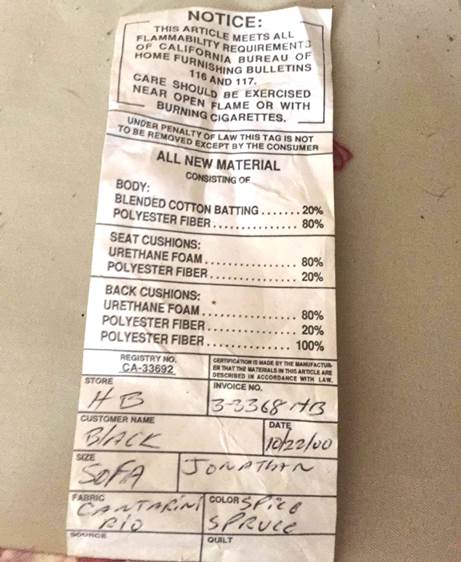
The label from the bottom of the author’s couch, by Lisa Terrell (used with permission).
And this poison had no upside. Firefighters and fire safety experts know that blending flame retardants into foam actually creates deadlier fires, accelerating the progression of flames in real-world fires and making a fire’s smoke more deadly. Scientists and public health advocates know that flame retardants can make living things infertile, impotent, stunted, overweight, diabetic, malformed, sickly, mutated, cancerous, or even dead. And manufacturers know that poisoning their customers is bad business, and blending flame retardants into foam is expensive, burdensome, and often requires duplicative testing.
But despite an impressive coalition of firefighters, nurses, public health officials, environmentalists, and toxicologists, reforming the old flammability standard seemed Sisyphean. Repeated attempts to curtail toxic flame retardants in furniture foam failed.
If you bought a product with foam manufactured in North America in the last 40 years, your upholstered purchase was almost certainly poisoned.
The reason? Profit. Four chemical companies dominated the flame retardant market for furniture foam sold in North America. Replacing the feckless flammability standard would decimate their billion-dollar boondoggle. Thus, Big Chem created phony grassroots front groups, produced stunningly deceptive expert testimony, lined the pockets of lawmakers, and, in a last-ditch effort, even sued to defend its bottom line.
In 2013, though, California Governor Jerry Brown tossed out his state’s outdated, scientifically discredited flammability standard in favor of a common sense, non-toxic alternative based on sound fire science. (Interestingly, he had signed the old standard into law during his first stint as governor.) Most manufacturers say they can comply with the new standard without adding flame retardants to furniture foam, though the regulations do not ban their use. In 2014, Gov. Brown passed a law requiring furniture manufacturers to label consumer products containing flame-retardant chemicals. On January 1, 2015, both laws went into effect.
Consumer and commercial money talked, manufacturers listened
Led by Kaiser Permanente, the healthcare industry pushed the market to adopt these changes more quickly than they would have otherwise. Backed up by $50 million of furniture purchases each year, Kaiser and other healthcare systems announced that by 2016, they would not buy furniture treated with flame retardants. By the end of 2014, companies spending more than $520 million annually on furniture signed the Center for Environmental Health’s Purchaser’s Pledge to preferentially purchase furniture made without flame retardants.
With consumer and commercial demand indicating a large and growing market for flame-retardant-free furniture, companies including Crate and Barrel, Room & Board, Williams-Sonoma (Pottery Barn, West Elm), IKEA, La-Z-Boy, The Futon Shop, Scandinavian Designs, and Wal-Mart quickly announced they would sell non-toxic, fire-safe furniture. Ashley Furniture, the nation’s largest furniture retailer, announced it would eliminate flame retardants from its furniture lines in March 2015.
How you can find a toxic-free couch
In the market for a new couch? The Green Science Policy Institute has compiled a list of manufacturers that sell retardant-free furniture, though this list is not comprehensive. And Natural Resources Defense Council (NRDC) produced an easy-to-follow guide for consumers.
First, find the flammability label attached to the furniture. It’s usually located underneath the furniture or under the cushions:
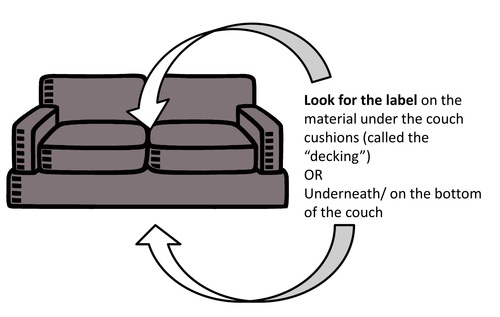
Where to find the flammability label, by NRDC. (Used with permission.)
You may see three different kinds of labels. Your best bet explicitly states that the furniture complies with Technical Bulletin 117-2013 and contains no added flame retardants:
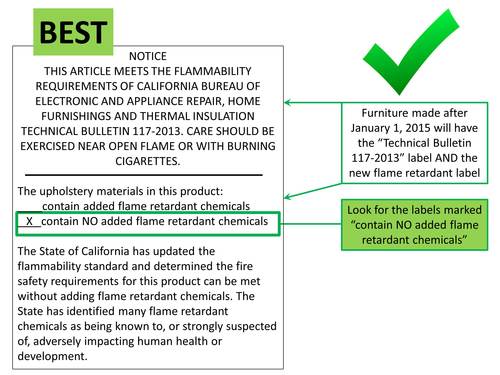
Non-toxic, fire-safe couch label, by NRDC. (Used with permission.)
But be aware that some manufacturers may still carry products that comply with the old flammability standard. In fact, a recent Washington Toxics Coalition survey found that nearly half of all sofas on the market contain or likely contain flame retardants. If you see this label, it is almost certainly toxic:
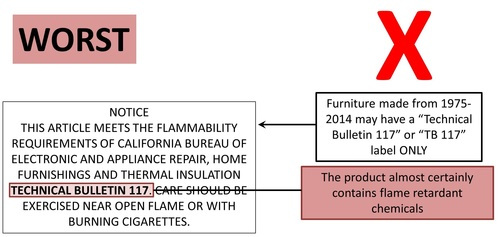
Toxic couch label, by NRDC. (Used with permission.)
Finally, products with labels with “Technical Bulletin 117-2013” or “TB117-2013” may or may not contain flame retardant chemicals. Ask the store staff, or check with the manufacturer.
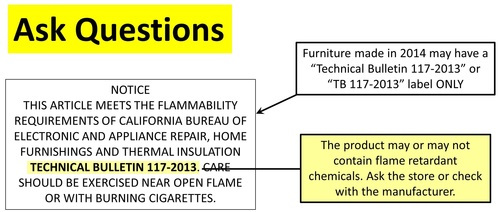
Ask questions re toxicity label, by NRDC. (Used with permission.)
Of course, you also might be wondering, “What do I do with my old couch?” You don’t want to create a “hand-me-down hazard,” as this Environmental Health Perspectives article sharply observes. So where Sightline would usually be all for reusing and recycling, the answer here is that our old, toxic furniture should go to the landfill, not to the second-hand store. Ideally, it would go to a hazardous waste facility. Unfortunately, these couches’ end-of-life questions are far from resolved, but meanwhile, we should not send these toxics downstream to others of us who simply can’t afford new furniture.
A new day for all our derrières
Having dogged this issue for years now, I am thrilled to see us turning a corner on a rule that was outdated, unscientific, and flat-out dangerous to our families and public health. Thanks to tireless research, organizing, and advocacy by a broad coalition of experts, officials, and concerned community members, I now have hope that by the time my new daughter is furnishing her first apartment with second-hand goods, she will be able to choose from a variety of fire-safe and non-toxic furniture.
Valerie Pacino is a recovering couch potato, who first became interested in California’s furniture flammability standard as a Sightline intern and a Master of Public Health student at the University of Washington.












Ray Kinney
Great! Now what? How about: Tackle box contamination of sportfishers by lead particulate coating box interiors and then contaminating hands, lunches, cooler ice, fish mucus, boat bottoms, and families when the fish go into the frying pan at home?
There is no level of lead intake that does not do harm to the nervous system. we should all go to a hardware store, purchase a cheap lead test kit, and go home to carefully swab our tackle box, to understand how we are poisoning what we love; our fish, ourselves, our families. The research lit is all there… read it. IMHO
Jessica Zimmerle
Thanks for raising awareness about this important environmental health and justice issue. I want to point out that on Friday, April 1 Governor Inslee signed the Toxic-Free Kids and Families Act, ESHB 2545 which bans 5 flame retardants and creates a system to evaluate others – making it the strongest ban in the nation! A broad coalition of advocates in the Toxic-Free Legacy Coalition – including the faith community, health professionals, disability advocates, teachers, and more – have worked on this bill for many years. It would be wonderful to see an article on how WA is leading in flame retardant reform, thanks!
Carmen
I really appreciated all the information you give us. Now I’ll be alerted when I have to buy furniture. I’m going to share this important information. Thanks again 😃
Erica Engle
I just purchased a new foam containing chair from Ikea a few days ago. Upon reading this article, I checked the furniture tags and found the best case possible. No flame retardant chemicals! Thank you Sightline and the Green Science Policy Institute for all your hard work over many years. It was very moving to find those tags and realize how directly your work matters to my own life! I will spread the word about this important issue.
Elizabeth Brand
What about an Italian couch from December of 2012 labelled Calif BS 5852? It looks like it is covered with wool. Would it then pass the British standard without additional fire retardants in the foam? So far the manufacturer has been evasive to my emails.
Elizabeth Austin
The label on my sofa says, not treated with flame retardant chemicals but, my sofa smells…mu h like the smell of a recently painted room.
Any suggestions?